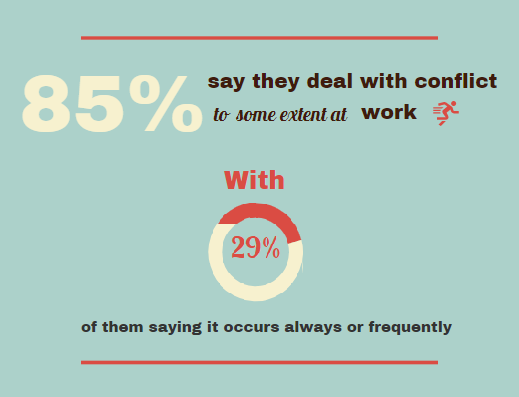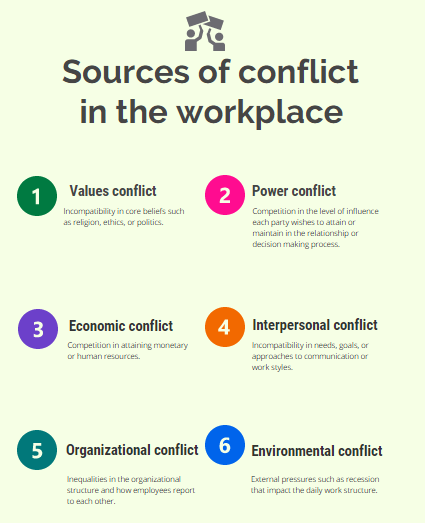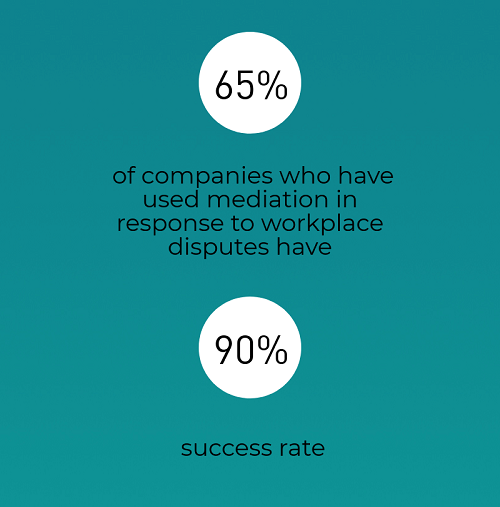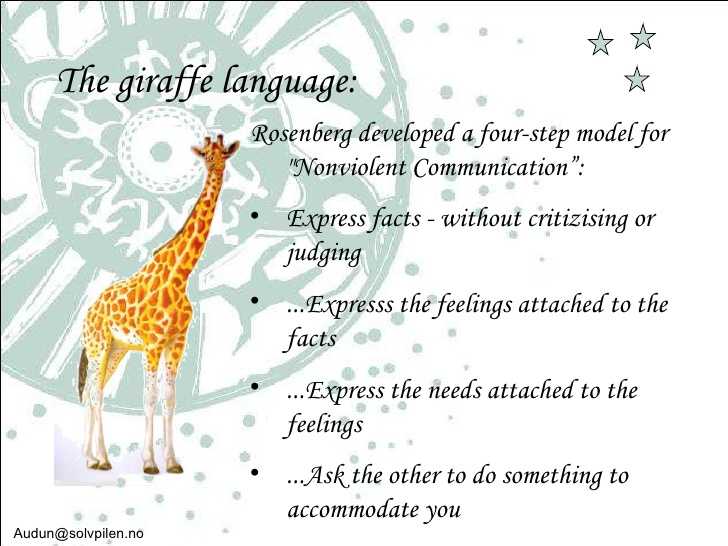How to solve problems in the workplace

Small Business Owners, Managers, HR Managers, Team Leaders:
How are you dealing with conflicts in the workplace? what you do when two employees can't work together anymore?
This article will answer all of your workplace problems questions. Here are the main topics to be discussed:
- What's conflict?
- Conflict between employees in the workplace
- What causes conflict in the workplace?
- The real cost of workplace conflict
- How unresolved conflict can harm your business?
- The 5 tips for healthy workplace conflict resolution
- Conclusion
Let's dive in:
1. What's Conflict?
No one wakes up thinking, ‘boy, I sure am really wrong about my beliefs.’
People generally have strong convictions about what they believe in, that’s why they believe it. And when you combine people with varying takes on life, there are bound to be clashes in those belief systems.
These clashes could be small differences in opinions or overwhelming differences in ideology. Either way, one or all parties involved perceive some threat to their needs, interests, or concerns.
When this occurs, the conflict can quickly grow beyond the original parties involved. People in conflict often reach out to members of their social system (friend group, work team, family, political affiliates, classmates, etc.) to persuade others to ‘take sides’.
As more people take a position in the conflict – muddying the proverbial waters – it becomes more and more difficult to define the parties involved.
Unfortunately, people respond based on their perceptions of the situation, their desires to be loyal, and their emotional state, rather than the objective facts presented to them.
For this reason, it is important to untangle emotional and relationship complexities to get back to the core of the issue.
Today, we will concentrate on navigating these complexities for one type of conflict: workplace conflict.
2. Conflict between employees in the workplace
The fact that no two people share the exact same perspective is fundamentally a good thing. Differences in experience and outlook lead to creativity and innovation. So, having some minor conflict in the workplace can actually be an advantage.
Your goal shouldn’t be to extinguish conflict altogether. That goal is not only counterproductive, it’s probably impossible.

Most employees (85%) say they deal with conflict to some extent at work, with 29% of them saying it occurs always or frequently.
A better goal is to nurture healthy conflict, while monitoring for signs caustic conflict that impedes productivity and workplace satisfaction.
Due to the interdependency of employee relationships and the real-world impact of decisions in the workplace (i.e. raises, hours, bonuses, and promotions can affect self esteem and one’s ability to afford their lifestyle), the workplace can be a breeding ground for unhealthy conflict.
Around 16% of conflicts in the workplace will escalate to an unhealthy level.
Left to fester, unhealthy conflict can easily turn into a hostile work environment that results in constant employee turnover, absenteeism, presenteeism, or even litigation.
The cause and remedy of conflict is the same: communication. But when 60% of employees have never received basic conflict resolution training, finding the right way to communicate can be difficult. Especially when most people have a natural tendency to avoid or ignore conflict.
3. What causes conflict in the workplace?
Just like the level of conflict, the source of conflict matters in how you approach it. As a manager, it’s important to understand how conflict can start and the various ways it can manifest in the workplace.
First, watch for early warning signs.
If you sense tension in a room of colleagues or notice crossed arms, avoidance of eye-contact, or someone sitting away from the group, these could be key indicators that it’s time to intervene.

There are many reasons employees enter conflict. Be sure to familiarize yourself with the most common reasons, so you can be prepared to discuss them:
(1) Values conflict: Incompatibility in core beliefs such as religion, ethics, or politics.
(2) Power conflict: Competition in the level of influence each party wishes to attain or maintain in the relationship or decision making process.
(3) Economic conflict: Competition in attaining monetary or human resources.
(4) Interpersonal conflict: Incompatibility in needs, goals, or approaches to communication or work styles.
(5) Organizational conflict: Inequalities in the organizational structure and how employees report to each other.
(6) Environmental conflict: External pressures such as recession that impact the daily work structure.
Knowing the source of workplace conflict is a good first step toward resolving it. Taking time to understand why a conflict is occurring will allow you to collect the right tools to approach it properly.
In the US, employees spend an average of 2.1 hours per week dealing with conflict. That equates to about $359 billion hours paid for unproductive time focused on conflict.
4. The real cost of workplace conflict
Imagine if all that time was spent on collaboration!
When things get completely out of control and employees decide to go to court, that can be another big cost to employers. On average, a company can expect to pay $125,000 for defense and settlement in cases like this.
In addition to defense and settlement costs, the median judgement is roughly $200,000, with 25% of cases receiving a judgement over $500,000.
Fortunately, most employee conflicts don’t end in a court battle, but even so, the company will have costs to pay.
Unhappy employees who are tangled in conflict at work may be less motivated. And while an engaged worker in their 40s costs $127.76 a month due to sick days taken, an unengaged employee of the same age costs $236.20.
An 85% increase!
And if that’s not enough of an impact to your bottom line, your top 1% employees add about $5000 in profit per year, while destructive employees cost about $12,000.
Enough unhappy, destructive employees could easily tank your business.
5. How unresolved conflict can harm your business?
To illustrate how a bad work environment can impact employees, let’s think a little about the average employee’s time.
Let’s say your employee gets the recommended 8 hours of sleep a night. That leaves 16 hours of waking time each day.
And if they spend 8 of those hours at work, that’s half of their waking hours, 5 days a week, spent at work. HALF.
That’s a big percentage of their time to spend in a toxic environment.
And for employees who experience this, it can take a big toll on mental health.
It’s easy to become over-stressed when such a big part of your life is going wrong. Symptoms include insomnia, loss of appetite or overeating, headaches, and mood swings.
Frustration with conflict can also take focus away from goals, instead placing focus on the conflict, the source of frustration. Other employees who are not originally part of the conflict can also be swept off course when frustrated employees feel the need to vent.
Eventually, frustrated employees will reach their breaking point. This could mean leaving the organization and seeking other opportunities, or in more extreme cases, it could mean violence.
The latter option not only puts all employees at risk, it opens the organization to imminent legal action.
6. The 5 tips for healthy workplace conflict resolution
Unresolved conflict can feel like an uphill battle with no hope for resolution. By arming yourself with the right tools and employing the right tactics, rest assured, a resolution can almost always be found.
To help you organize your thoughts and strategize your action plan, we have listed our top 5 suggestions:
- Realize workplace conflict is inevitable
- Nip it in the bud
- Ask!
- Use the Giraffe language
- Get to mediation
Ok let's dive in and detail every step:

6.1. Realize workplace conflict is inevitable
Where there’s a relationship, there’s conflict. There is no amount of training, bonding activities, or monitoring that will completely extinguish conflict in the workplace.
And that’s ok. A little bit of conflict, handled the right way, can actually be a good thing. Innovation is impossible without conflict, and most of the time it just means people care enough about something to share their views.
However, the caveat, ‘handled the right way’, is an important distinction to make. When conflict goes unchecked, it can turn into something unhealthy for everyone involved.
It’s important to strike a balance between being over-vigilant about every disagreement and being neglectful of urgent warning signs. With practice, you’ll get there.
6.2. Nip it in the bud
It’s tempting to believe that conflicts will blow over on their own, and depending on the personalities involved, this may not be far from the truth.
But too often, conflict only gets worse with time.
It may be hard to believe, but 90% of workplace conflict does not stem from what was said, it comes from what wasn’t said.
And ignoring the fact that something is amiss is like miracle grow for conflict.
Both parties are left imagining the intentions of the other, rather than expressing and listening to the actual intentions.
So, before imaginations are allowed to run wild, it’s important to open the lines of communication.
This is much true in case you are are managing a situation where bullying has been alleged in your workplace. Consult this book to check how how to resolve bullying in the workplace.
6.3. Ask!
You might not be 100% sure of the best way to open the lines of communication, but the most powerful tools are often the most simple: just ask.

Before we move on to the next point, it’s important to note that there’s a big difference between asking someone for clarification, and DEMANDING satisfaction.
Try to avoid language that’s unconstructive (and yes, expletives are always unconstructive).
Don’t be coy. If you or the other person leaves the conversation with more questions than you had going in, it was not a success.
Just let the other party know what you’ve noticed and ask about motivation in a calm manner.
They may have a perfectly good explanation that makes sense to you. If not, well, now the conversation has at least started and can continue.
6.4. Use the Giraffe language
‘Giraffe language’ is a great tool for an ongoing conflict. It starts with an invitation:
- Invitation: Invite the other person to talk about the conflict. Make sure to schedule the conversation for a time that is convenient for both of you. If the other person is focused on something else, they are more likely to get more annoyed with you rather than try to work it out.
- Observation: Let the other person know what you’ve noticed in the most objective way you can. This is where you list out the who, what, where, when, why of the situation as you see it.
- Apologize: Conflict is never one sided. Identify what you did wrong and apologize for it.
- Appreciate: Acknowledge the positive aspects of the other party and let them know why it is important to you to resolve the conflict.
- Consequences: Identify why the conflict is an issue. What problems have resulted from being in conflict?
- Objective: Share what you think the best outcome of the situation would be.
- Request: Ask for suggestions about specific actions that can be implemented right away and decide on an agreeable solution.
When you come up with a plan, stick to it! It may be tempting to backslide into old habits, but keep in mind why it is important to keep trying the new way.
6.5. Get to mediation to solve problems in the workplace
Even with the best of intentions, sometimes people are just too close to conflicts to resolve them on their own. And when managers get involved, it can be difficult not to let emotions about each employee cloud responses to their concerns.
If there is even a whiff of favoritism in the decided action, it can amplify the conflict rather than end it.
In cases like this, hiring a neutral third party to help employees work through their issues is the best option, and gives you an opportunity to settle your dispute out of court.
Hiring a qualified mediator is far less expensive to your organization than letting conflicts fester and ensures that each employee will get an equal chance to express their concerns.

Mediation is becoming a more popular tool to help companies resolve conflict. National surveys indicate that 65% of companies have used mediation in response to workplace disputes, with a 90% success rate.
There are many situations where mediation can be helpful. For instance, 70% of the time, it is employed to resolve issues surrounding on-going relationships, while the remaining 30% of cases are aimed at solving issues following termination.
Mediation is a great option, but be sure to find a workplace mediator that both parties agree on. This is a good tactic to start mediation on the right note.
You may like to read: ADR Will Make you Resolve your Conflicts Peacefully!
7. Conclusion
When you feel like your workplace is isolated in its conflict, remember that workplace conflict is very common. In fact, 85% of employees admit that it’s something they deal with.
Conflicts can stem from anywhere, but the most common causes are differing values, power dynamics, economic issues, interpersonal issues, changes in organizational structure, and environmental pressures.
Left long enough, any of these types of conflict can result in serious negative impact on the company. Things like loss of productivity, increased sick days, and mental health issues can translate into major financial cost.
On average, $359 billion dollars are spent nationwide on unproductive conflict-related issues.
But as a manager, arming yourself with tools like giraffe language and learning to act quickly will mitigate the amount your company needs to spend on conflict.
And if conflict goes beyond a place where it can be resolved in-house, there is still another option left!
Hiring a mediator presents a cost-effective solution to solve problems in the workplace disputes. And a neutral third party can help employees feel like their concerns are important and heard.
If you’re ready to take that step, you can easily find a qualified mediator near you using the MediatorSelect directory.
Now we want to hear from you. Let us know your thoughts on techniques and tips for workplace conflict resolution in the comments below!




